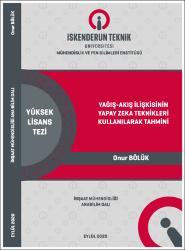| dc.contributor.advisor | Üneş, Fatih | |
| dc.contributor.author | Bölük, Onur | |
| dc.date.accessioned | 2020-12-17T09:26:55Z | |
| dc.date.available | 2020-12-17T09:26:55Z | |
| dc.date.issued | 2020 | en_US |
| dc.date.submitted | 2020 | |
| dc.identifier.citation | Bölük, O. (2020). Yağış-akış ilişkisinin yapay zekâ teknikleri kullanılarak tahmini. (Yüksek Lisans Tezi). İskenderun Teknik Üniversitesi / Mühendislik ve Fen Bilimleri Enstitüsü, Hatay. | en_US |
| dc.identifier.uri | https://hdl.handle.net/20.500.12508/1514 | |
| dc.description.abstract | Su kaynaklarının kullanımı, korunması ve ekonomik ömrünün belirlenmesi amacıyla; yağış-akış verilerinin analiz edilmesi, yapılan analizler neticesinde elde edilen verilerden tahminler yapılması önemlidir. Bu sebeple yağış-akış ilişkisinin yapay zekâ tekniği ile tahmini için günümüzde yaygın olarak kullanılan çoklu doğrusal regresyon (ÇDR) metodu, doğrusal olmayan regresyon metotları, yapay sinir ağları (YSA) metodu ve genelleştirilmiş regresyon yapay sinir ağları (GRYSA) metodu tercih edilmiştir. Çoklu doğrusal olmayan regresyon metotlarından etkileşim regresyonu (IR), saf ikinci dereceden regresyon (PQR) ve karesel regresyon metodu (QR) ile analiz yapılmıştır. Bu çalışma metodu için Amerika Birleşik Devletlerine ait Muskegon havzasının içerisinde Newaygo bölgesi yakınlardaki istasyona ait 2014-2018 tarihleri arasındaki 1396 günlük sıcaklık, yağış ve akış verileri kullanılmıştır. Bölgeye ait olan 1396 günlük hidrolojik ve mevsimsel parametreler kullanılarak yapay zekâ tekniği yöntemleri ile tahmin çalışması yapılmıştır. Çalışmada her bir yöntem için, debi ve yağış zaman serileri kullanılarak 2 farklı analiz (ÇDR1, ÇDR2; IR1, IR2; PQR1, PQR2; QR1, QR2; YSA1, YSA2; GRYSA1, GRYSA2) seçilmiştir. Bu yöntemler kullanılırken; determinasyon katsayısı (R2), mutlak ortalama hata (OMH) ve ortalama karesel hataların karekökü (KKOH) kullanılarak karşılaştırma yapılmıştır. Ölçüm ve model sonuçları karşılaştırıldığında; kullanılan yöntemlerin hepsi yağış akış ilişkisi belirlenmesinde güzel sonuçlar vermiş olsa da; YSA2 ve GRYSA2 modelleri en yüksek determinasyon katsayılarına ve en düşük hata miktarlarına sahiptir. GRYSA1 ve ÇDR1 modelleri en yüksek hata, en düşük determinasyon katsayılılarıyla tüm modeller içerisinde en düşük performansı göstermiştir. YSA yönteminin yağış - akış modellemesinde düşük hata ve yüksek determinasyon ile en iyi tahmini verdiği gözlenmiştir. Bu sebeple yağış-akış modellemelerinde klasik yöntemlere alternatif olarak YSA yöntemi kullanılabilir. | en_US |
| dc.description.abstract | In order to determine the use, protection and economic life of water resources; It is important to analyze the precipitation-flow data and make estimates from the data obtained as a result of the analysis. For this reason, multiple linear regression (MLR) method, non-linear regression methods, artificial neural networks (ANN) method and generalized regression artificial neural networks (GRNN) method have been preferred for the prediction of precipitation-flow relationship with artificial intelligence technique. Analysis was performed by interaction regression (IR), pure-quadratic regression (PQR) and quadratic regression method (QR), which are among the multiple nonlinear regression methods. For this method, 1396 daily of temperature, precipitation and flow data between 2014 - 2018 of the station in Newaygo region in the Muskegon basin of the United States was used. Prediction study was done with artificial intelligence techniques by using hydrological and seasonal parameters of 1396 days belonging to the region. In the paper, 2 different analyzes (MLR1, MLR2; IR1, IR2; PQR1, PQR2; QR1, QR2; ANN1, ANN2; GRNN1, GRNN2) were selected for each method using flow and precipitation time series. While using these methods; Comparison was made using determination coefficient (R2), mean absolute error (MAE) and root mean of square errors (RMSE). When the measurement and model results are compared; although all the methods used gave good results in determining the relation of precipitation flow; ANN2 and GRNN2 models have the highest determination coefficients and lowest error amounts. The highest error of GRNN1 and MLR1 models showed lower performance among all models with the lowest determination coefficients. It was observed that ANN method gave the best estimation with low error and high determination in precipitation - flow modeling. For this reason, ANN method can be used as an alternative to classical methods in precipitation-flow modeling. | en_US |
| dc.language.iso | tur | en_US |
| dc.publisher | İskenderun Teknik Üniversitesi / Mühendislik ve Fen Bilimleri Enstitüsü / İnşaat Mühendisliği Anabilim Dalı | en_US |
| dc.rights | info:eu-repo/semantics/openAccess | en_US |
| dc.subject | Yağış – akış ilişkisi | en_US |
| dc.subject | Yapay sinir ağları | en_US |
| dc.subject | Çoklu doğrusal regresyon ve çoklu doğrusal olmayan regresyon | en_US |
| dc.subject | Tahmin | en_US |
| dc.subject | Rainfall – runoff | en_US |
| dc.subject | Artificial neural network | en_US |
| dc.subject | Multiple linear regression and multiple non- linear regression | en_US |
| dc.subject | Estimation | en_US |
| dc.title | Yağış-akış ilişkisinin yapay zekâ teknikleri kullanılarak tahmini | en_US |
| dc.title.alternative | Prediction of rainfall – runoff relationship using artificial intelligence techniques | en_US |
| dc.type | masterThesis | en_US |
| dc.contributor.department | Mühendislik ve Fen Bilimleri Enstitüsü | en_US |
| dc.relation.publicationcategory | Tez | en_US |
| dc.contributor.isteauthor | Üneş, Fatih | |
| dc.relation.index | İndeks Bilgisi Yok | en_US |
















